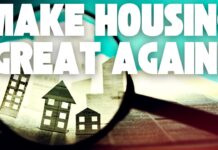Let’s Talk Tariffs (Without the Boring Stuff)
Tariffs. Yep, that word alone can make your eyes glaze over. But stick with me—because understanding tariffs might just give you an edge in your real estate business. Believe it or not, these little taxes on imported goods can ripple through the economy and land right on your front porch (literally).
What Are Tariffs, Anyway?
In plain English, a tariff is a tax on stuff we buy from other countries. Think of it like an entrance fee for imported goods. When those goods get more expensive, people tend to buy American-made products instead. But here’s the kicker: tariffs don’t just affect prices at Walmart; they can shake up entire industries, create jobs, and even change the landscape of U.S. cities.
A Blast from the Past: When Tariffs Paid the Bills
Way back in the day (we’re talking William McKinley era, 1897-1901), the U.S. didn’t even have a federal income tax. Instead, tariffs covered the government’s bills. Fast-forward to today, and there’s talk about whether tariffs could replace federal income taxes altogether. Imagine that—no more income tax, just tariffs.
Could This Happen? Well, Let’s Do Some Math (Quickly, I Promise):
- The government collects around $2.5 trilliona year from income taxes.
- To replace that with tariffs, we’d need an average tariff rate of about 57%on all imported goods.
- Sounds wild? It is… but not impossible.
The Timeline to a Tariff-Based Economy
- Short-Term (1-5 years):Expect inflation as import costs rise. Construction costs might increase temporarily due to higher prices on materials like Canadian lumber, which now faces a 25% tariff. However, job growth in U.S. industries will boost home demand, potentially offsetting these costs.
- Medium-Term (5-10 years):S. manufacturing ramps up, easing inflation. Domestic material production stabilizes, reducing construction costs. Real estate markets in manufacturing hubs start booming.
- Long-Term (10-20 years):A fully tariff-supported economy could stabilize, potentially replacing federal income taxes altogether.
So, What Does This Mean for Real Estate?
Here’s where things get juicy. Tariffs don’t just raise prices; they shift economic power. When imported goods cost more, companies bring manufacturing back to the U.S., creating jobs. More jobs = more people buying homes. Simple, right?
Where Are the New Boomtowns?
If the U.S. ramps up manufacturing again, some areas are poised to explode with growth. Picture these regions becoming the next real estate hotspots:
- Midwest Revival:States like Michigan, Ohio, Indiana, and Wisconsin could see a resurgence. Think factories buzzing, workers moving in, and homes selling like hotcakes.
- The South Rises (Economically):Alabama, Tennessee, and Georgia are already industrial hubs. More tariffs? More factories. More factories? More families needing homes.
- Rust Belt Reboot:Cities like Pittsburgh, Buffalo, and Cleveland could shake off the rust and shine again. Picture trendy lofts in old warehouses and booming downtowns.
Wait, Won’t This Make Houses More Expensive?
Good question. Yes, in the short term, construction costs might rise because materials like steel and lumber could get pricier due to tariffs—for example, the 25% tariff on Canadian lumber. But here’s the flip side: wages will go up as more people get good-paying jobs. Higher wages mean more buyers who can afford homes.
Why Would Costs Rise If We Have Domestic Suppliers?
Even with domestic suppliers, costs might initially increase because:
- Supply Constraints:S. manufacturers may struggle to meet sudden demand, causing short-term price spikes.
- Higher Production Costs:Domestic production often has higher labor and energy costs compared to imports.
- Transition Period:Shifting supply chains isn’t instant; time is needed to ramp up production capacity.
- Labor Shortages:More demand for skilled labor can push wages higher, affecting construction costs.
Inflation? Yes. But Not Forever.
Sure, tariffs might cause a little inflation at first. But as U.S. factories ramp up, supply meets demand, and prices stabilize. Plus, with no federal income tax (if that happens), people keep more of their money—which could offset higher prices.
The Positive Side of Tariffs: Lessons from History
While many focus on the challenges of tariffs, history shows their potential benefits:
- Industrial Growth:In the late 19th century, high tariffs helped the U.S. become an industrial powerhouse during the Gilded Age, fueling rapid economic growth and job creation.
- Protecting Emerging Industries:Tariffs shield young industries from foreign competition, giving them time to develop and become globally competitive.
- Revenue Generation:Before the federal income tax was introduced in 1913, tariffs funded most of the U.S. government, supporting infrastructure and public services without taxing personal income.
- Boosting Domestic Supply Chains:Higher tariffs can encourage local production of materials, reducing reliance on imports and stabilizing costs over time.
The Net Effect on the U.S. Economy Over Time:
- Short-Term (1-5 years):Inflation spikes (3-5%), but job growth in domestic industries fuels housing demand.
- Medium-Term (5-10 years):Manufacturing growth stabilizes inflation. Housing markets thrive in new industrial hubs.
- Long-Term (10-20 years):A robust economy with strong domestic production supports sustained real estate growth.
The Bottom Line for Real Estate Pros:
- Follow the Jobs:Where new factories go, people follow. Watch for announcements about new manufacturing plants and start farming those areas.
- Think Long-Term:Short-term price hikes in construction could mean higher commissions on new homes down the road.
- Adapt:Be ready to shift your focus to emerging markets. Yesterday’s sleepy town could be tomorrow’s booming suburb.
So, the next time someone mentions tariffs at a dinner party, you can skip the eye-roll and say, “Actually, they might just create the next real estate gold rush.”
By Tim and Julie Harris (c) TimandJulieHarris.com
About the Authors:
Tim and Julie Harris are nationally recognized real estate coaches, authors, and hosts of the popular “Real Estate Coaching Radio” podcast, the #1 daily podcast for real estate agents. With decades of industry experience, they help real estate professionals achieve their goals through proven strategies and expert insights. Tune in to their podcast at TimandJulieHarris.com or find them on your favorite podcast platform.





























